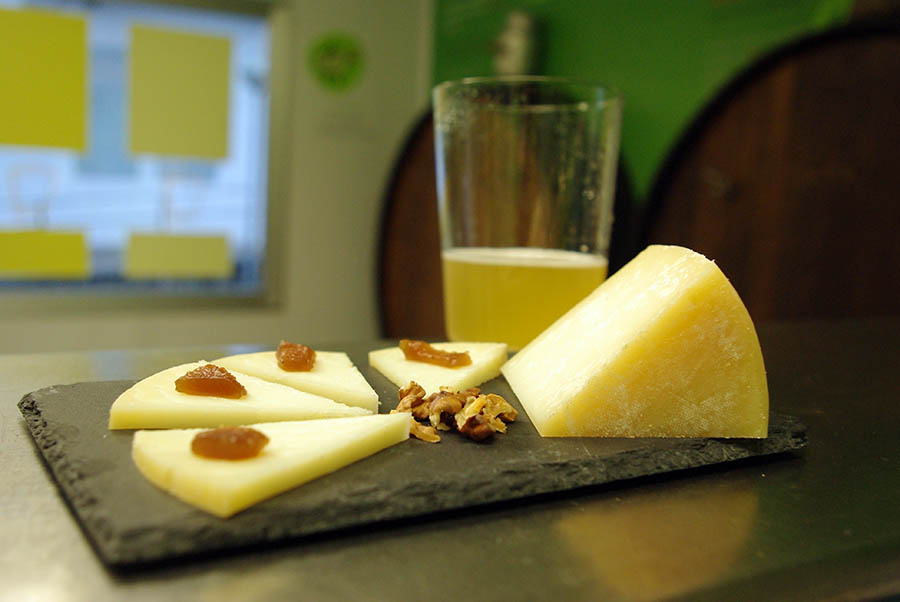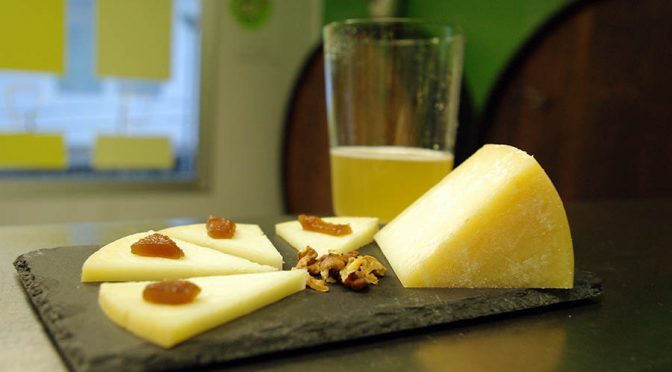There is a story that, millennia ago, a Basque shepherd was working under the hot southerly wind. The night before, he had finished a lamb for his dinner and, today, he used the lamb’s hide to hold milk. He then trekked home — this all took place near the modern town of Eibar — and upon reaching his house, he found that the liquid milk had solidified; he had accidentally discovered cheese. Whatever the true origin, today there are over 2000 varieties of cheeses made around the globe.

- Cheese has been part of human culture for thousands of years. The oldest description we have comes from the Sumerians, somewhere between 3100 and 3500 BCE. Homer describes cheese mixed with nuts and honey in the Odyssey in about the 9th century BCE. There are mentions of cheese in the Bible, in the books of Samuel and Job, that are from around 500 and 1000 BCE. And, in the Basque Country, there are clay pots dated about 3000 years old that could have been used to make cheese.
- The proliferation of cheese is due, in part, to the fact that it is an easy way to preserve milk. Most milk production occurs far from population centers, in the shepherd’s txabola or hut. With milk quickly spoiling in heat, the shepherd needed a way to preserve it so he could get it to market. Cheese is a convenient way to monetize dairy production.
- Even so, for some people, cheese was scarce. During the first industrialization of the Basque Country (the last quarter of the 19th century), working-class and mining families barely tasted milk, eggs and fresh vegetables, much less cheese. In contrast, the peasantry fed on less meat than the worker, but they had milk, eggs and vegetables in their diet. A typical farmer from Gipuzkoa fed mainly on corn bread, and to a lesser extent wheat, milk, potato, chestnut, bean, broad bean, collard greens, bacon, jerky, apples, and, of course, cheese.
- The discovery of pasteurization in the mid 1800s by Louis Pasteur (of course) changed dramatically the way cheese was made. Now, milk from multiple animals could be mixed. Milk that is unstable and weak to bacteria, such as cow milk, could then be mixed with sheep or goat milk through pasteurization.
- In the Basque Country, sheep milk cheeses are much more common than cheese made from cow or goat milk. This is because of the latxa, the native sheep of the Basque Country, which produces milk ideal for cheese making. A good band of 100 latxa can produce 80-100 liters (20-26 gallons) of milk per day.
- Today, cheese makers use tools and equipment made of aluminum or other metals that can be easily sterilized, but in the old days, these tools were made of wood. The kaiku is a wooden container used to milk the animal. Hot stones could be added to cook the milk, making mamia or gaztanbera, or cuajada — a cheese curd served as dessert. Strainers are used instead of cloth filters which, in the old days, were used with nettles, which were thought to help filter impurities.
- There are three primary types of cheese made in the Basque Country: Roncal, made in Nafarroa from sheep milk with a very intense flavor and aroma; Ossau-Iraty cheese, again made from sheep milk, which has a more fruity or nutty flavor; and the most famous, from Idiazabal, which uses unpasteurized latxa milk to give its distinct flavor. However, cheeses are made everywhere, even in individual baserri, and come in as many varieties as there are cheese makers.
- There is a walking trail in the famous Idiazabal region where you can stop at multiple places to sample cheese. Part of the greater European Cheese Route initiative, you can experience the great outdoors while sampling delicious cheeses. Idiazabal also hosts the Feria del Queso, highlighting the cheeses made by Basque shepherds.
Primary source: Aguirre Sorondo, Antxon. El queso. Enciclopedia Auñamendi. Available at: http://aunamendi.eusko-ikaskuntza.eus/es/el-queso/ar-150132/
Discover more from Buber's Basque Page
Subscribe to get the latest posts sent to your email.



Cheese, cheese–I cannot imagine finishing a meal without a piece of cheese–and yes, in my opinion, the best cheese is form the latxa race. In New Mexico there is an abundance of latxa ( churra) called churro in NM. For reasons I cannot understand, the churra growers, not just NM but from all 50, 51 now with DC, ( why not sheep on the lawn of the white house to keep company to the turkeys already there) exhaust their resources trying to sell the wool of churra that no one wants. why not make cheese with the churra.
I read something a long time ago that only men made cheese. There is a myth associated with this custom. If it is a custom as only men, a long time ago, where practicing transhumance.